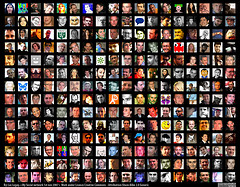Anya and I have been excessively excited for the “small” change that Facebook made the other day that allows you to use the Twitter-esque “@” symbol to add contacts, pages, groups etc to a conversation pretty much anywhere you would normal post content on Facebook.
For example, on our Facebook page, you’ll see that once I inputted “@,” a drop-down menu pops up where you can choose from your contacts, your groups, your pages, etc. I was posting up Anya’s post on academics having open access to scholarly work and wanted to attribute it to her, and I also got to let her know that I did so. You’ll then see the prior post, citing Adam’s thoughts on social media ROI, and his name has been tagged.
Since I’m pretty interested in what this means for viral capabilities, I was playing around with the Walls today. Here’s what I’ve seen so far just using Wall postings.
Personal Profile:
- You can post a status update with a contact name and/or a public profile (businesses/organizations) and your update will show up on their or its news feed. [Note: It does not seem to update on a group page]
- If it’s a contact, they will be notified via email, just as they would if you had tagged them in a photo in your own album (assuming they’re set up for email notifications). [Update: if you go to our FB page now, you'll see that Adam has already commented on the link we posted. Most likely because he was notified that we posted it.]
- Your tagging allows people to click on the contact/group/etc directly from your newsfeed, or their own home feed.
- You can only link to contacts that you’re friends with, groups that you’re a member of or pages that you’re a fan of.
Business Public Profile/Page:
- Much the same as a Personal Profile.
- You can post an update or a link with the same information as above, and tag someone you’ve mentioned. Again, groups do not seem to be affected.
- It it’s a contact, they will be notified that they’ve been tagged.
- Other fans of the page are able to click directly through to the tagged party, whether it’s the author of a posted link or a group that was mentioned.
- Any fan can post something that is tagged with a contact/page/group that they are connected to.
Implications for business:
- You are in front of more people, in places more removed than your page. Being tagged allows you to reach people one layer out, by being able to be mentioned in a way that’s interactive on profiles and pages that are not your own. Because your fans also have these capabilities, anytime you’re mentioned by them, you’re exposed to all of their contacts in the same way.
- It draws people back to your page more easily. If your page is tagged “somewhere else” it is much easier for new eyes to connect to your page, click, and be there. No one has to actually interact with your page directly for that to happen now. If a person is tagged on your page, they’re notified of that discussion, which isn’t directly on their profile. This will ideally bring them to your page. All-in-all, you’re drawing people back to your content from further away and in an easier manner.
Still playing around, I’ll update when/if I find new features.
Did I miss anything? Any other cool features you’ve come across that increase virality? Do I have anything wrong?
Related articles by Zemanta
- HOW TO: Use Facebook’s @Mentions Status Tagging (mashable.com)
- Twitter’s Tough Week: The Social Media Recap… (Mashable … (jonggunlee.tistory.com)
 I recently had a conversation with someone about numbers and social media. It was not unlike many conversations I’ve had before. I was asked to defend my mere 2,000 Twitter followers against someone else’s 5,000 or so. Doesn’t that make them better at social media? To his credit, he was merely playing with me, and was not necessarily a numbers guy himself, but many people DO base your skill level on this!
I recently had a conversation with someone about numbers and social media. It was not unlike many conversations I’ve had before. I was asked to defend my mere 2,000 Twitter followers against someone else’s 5,000 or so. Doesn’t that make them better at social media? To his credit, he was merely playing with me, and was not necessarily a numbers guy himself, but many people DO base your skill level on this!



